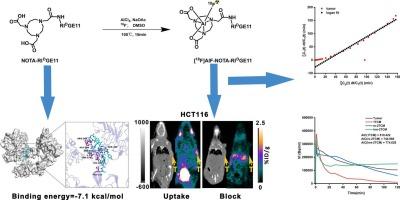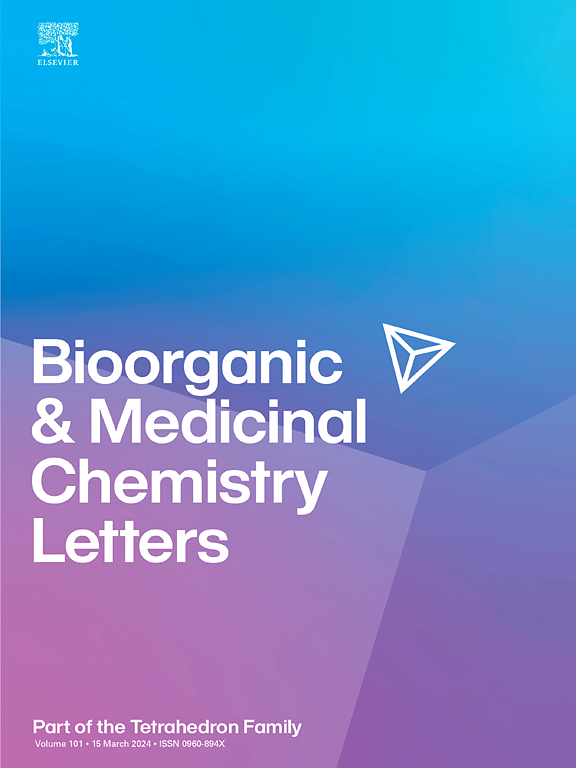Development and evaluation of [18F]AlF-NOTA-RIDGE11: A novel retro-inverso peptide PET probe for EGFR imaging
IF 2.2
4区 医学
Q3 CHEMISTRY, MEDICINAL
引用次数: 0
Abstract
The overexpression of epidermal growth factor receptor (EGFR) in multiple cancers establishes it as a valuable biomarker for targeted therapies and non-invasive imaging. This study developed a novel peptide-based PET probe targeting EGFR, [18F]AlF-NOTA-RIDGE11, by conjugating a NOTA chelator to the D-type retro-inverso isomer of LGE11 (RIDGE11) to enhance metabolic stability. Molecular docking reveals comparable EGFR binding affinity (−7.1 kcal/mol) to that of the native LGE11 peptide (−6.9 kcal/mol). Efficient radiolabeling was achieved within 30 min using the one-step 18F‑aluminum fluoride method (radiochemical yield of 18.3–28.4 %; radiochemical purity >99 %). The probe demonstrated high hydrophilicity (logD = −3.90 ± 0.01) with excellent stability in both vitro and vivo conditions (> 95 % intact after 2 h in plasma). In EGFR-positive HCT116 cells, [18F]AlF-NOTA-RIDGE11 exhibited specific and blockable uptake (60 min: 1.96 ± 0.11 % ID/1 million cells). Micro-PET imaging in HCT116 tumor xenografts revealed moderate tumor uptake (60 min: 1.49 ± 0.37 % ID/g) with rapid clearance from non-target organs, resulting in favorable tumor-to-background ratios (tumor/muscle: 9.24 ± 3.51; tumor/liver: 2.25 ± 0.11). Specificity was confirmed by a significant reduction in tumor uptake (1.32 ± 0.15 % ID/g vs. 0.30 ± 0.04 % ID/g at 60 min; p < 0.01) following co-injection with excess LGE11 peptide. Biodistribution analyses corroborated the imaging findings and indicated predominant renal excretion. Kinetic modeling identified a reversible two-tissue compartment model as optimal. While the high hydrophilicity contributes to rapid washout from tumors, [18F]AlF-NOTA-RIDGE11 exhibits promising characteristics for in vivo stability and pharmacokinetic properties, demonstrating its potential as a targeted tracer for EGFR-positive tumor imaging. Future studies will focus on probe optimization to enhance tumor retention.

[18F]AlF-NOTA-RIDGE11:一种用于EGFR成像的新型逆转录反肽PET探针的开发和评价
表皮生长因子受体(EGFR)在多种癌症中的过度表达使其成为靶向治疗和非侵入性成像的有价值的生物标志物。本研究通过将NOTA螯合剂偶联到LGE11的d型逆转录反相异构体(RIDGE11)上,开发了一种新的靶向EGFR的基于肽的PET探针[18F]AlF-NOTA-RIDGE11,以增强其代谢稳定性。分子对接显示EGFR的结合亲和力(−7.1 kcal/mol)与天然LGE11肽的结合亲和力(−6.9 kcal/mol)相当。使用一步18F氟化铝法在30分钟内实现了有效的放射性标记(放射化学产率18.3 - 28.4%;放射化学纯度>; 99%)。该探针具有较高的亲水性(logD = - 3.90±0.01),在体外和体内条件下都具有良好的稳定性(在血浆中2小时后95%完好无损)。在egfr阳性的HCT116细胞中,[18F]AlF-NOTA-RIDGE11表现出特异性和可阻断的摄取(60分钟:1.96±0.11% ID/ 100万细胞)。HCT116肿瘤异种移植物的显微pet成像显示,肿瘤摄取适度(60分钟:1.49±0.37% ID/g),非靶器官清除迅速,导致有利的肿瘤/背景比(肿瘤/肌肉:9.24±3.51;肿瘤/肝脏:2.25±0.11)。特异性通过联合注射过量LGE11肽后肿瘤摄取显著降低(60分钟时为1.32±0.15% ID/g vs. 0.30±0.04 % ID/g; p < 0.01)得到证实。生物分布分析证实了影像学发现,并表明主要是肾脏排泄。动力学模型确定可逆的两组织室模型为最佳模型。虽然高亲水性有助于快速从肿瘤中清除,[18F]AlF-NOTA-RIDGE11在体内稳定性和药代动力学特性方面表现出良好的特性,表明其作为egfr阳性肿瘤成像的靶向示踪剂的潜力。未来的研究将集中在探针优化以增强肿瘤保留。
本文章由计算机程序翻译,如有差异,请以英文原文为准。
求助全文
约1分钟内获得全文
求助全文
来源期刊
CiteScore
5.70
自引率
3.70%
发文量
463
审稿时长
27 days
期刊介绍:
Bioorganic & Medicinal Chemistry Letters presents preliminary experimental or theoretical research results of outstanding significance and timeliness on all aspects of science at the interface of chemistry and biology and on major advances in drug design and development. The journal publishes articles in the form of communications reporting experimental or theoretical results of special interest, and strives to provide maximum dissemination to a large, international audience.

 求助内容:
求助内容: 应助结果提醒方式:
应助结果提醒方式:


